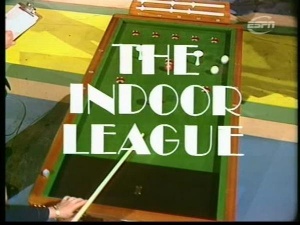Indoor League
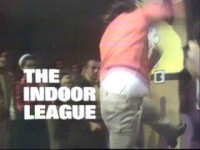
Contents |
Host
Fred Trueman
Co-hosts
Commentators:
Neil Cleminson (shove ha'penny)
Dave Lanning (darts/table skittles)
Keith Macklin (billiards/table football)
Kent Walton, Bill Maynard, Hector Meadus (unknown sports)
Broadcast
Yorkshire Television for ITV, 5 April 1973 to 28 March 1978 (72 episodes in 6 series)
Synopsis
For reasons time has since forgot, ITV was exceptionally proud of its much more regional existence compared to the primarily London-based BBC.
Many of its 1970s shows were unabashedly working class (Coronation Street being an excellent example), and they don't get more proletarian than this. Which other programme would have an overweight bloke with his shirt hanging out as its logo?
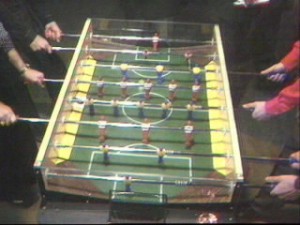 Remember: no spinning, now
Remember: no spinning, nowThe Indoor League must have been one of the most non-PC shows ever aired on lunchtimes. It was later relegated (or promoted, depending on your point of view) to the early evening.
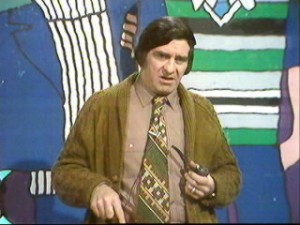 Cricketing hero, Fred Trueman
Cricketing hero, Fred TruemanSo, in brief what was it all about? It started with the camera panning around Fred Truman swigging a pint of bitter (always a promising start on kids TV!). A typical evening's entertainment revolved around a knock out contest in various pub games, some of which do not seem to exist anymore.
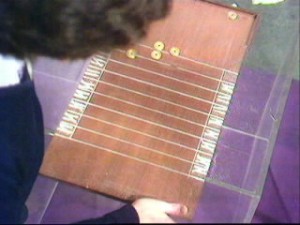 Shove ha'penny, a traditional English game somewhat made more difficult by there not being ha'pennies any more
Shove ha'penny, a traditional English game somewhat made more difficult by there not being ha'pennies any moreBar billiards was always a favourite - played on a sloping table with a timer running. The idea was pot the ball without knocking over a number of "mushrooms" placed on the table which resulted in severe penalties. If the ball was not potted it ran back to be re-struck. If it went into a pocket, it rolled back down a chute. When the timer ran out, the ball didn't come back.
The bar billiards was followed by arm-wrestling. Two gentleman with arms the size of small airships would inevitably end in stalemate with one guy having his wrist forced onto the table, but the other guy being unable to push the hand flat. Several minutes of air-time could be spent with no noticeable movement, except the odd grunt to show the players were still alive.
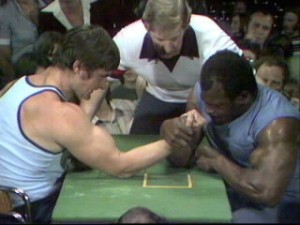 Now place the ring on the bride's finger
Now place the ring on the bride's fingerNine ball pool came next. This was an odd Brit version of the game which mankind has never seem before or since. It was played with yellow and red balls (presumably a black must have figured in the picture) but there were no dots and stripes as we all are familiar with now. Rest assured, for the original 15-ball game was also played.
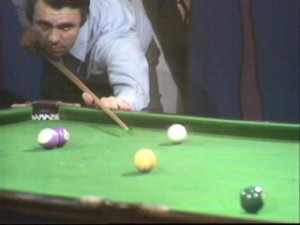 This advanced version used an invisible cue ball
This advanced version used an invisible cue ballHere's where things get a bit hazy, but there was also nine-pin bowling and weird skittles-type games. Darts was also featured heavily, bringing to light for the first time several World Champions to be. We're sure there were other games - dominoes might be one - but too many brain cells have bitten the dust to recall clearly. Maybe it's the beer.
Catchphrases
Signoff: "I'll see thee"
Theme music
Waiting for You by Andre Brasseur.
Trivia
The original producer was Mr Darts himself, Sid Waddell.
Recorded at The Queen's Hotel, Leeds (and later The Irish Centre, Leeds).
In spite of popular belief Indoor League wasn't the first networked TV programme to show darts – that honour belonging to the News of the World Championship, first networked by ITV in 1970. But even before that, the honour of being the first regional company to show darts falls to Westward Television who started up their own televised invitational championship in 1962.
Simon Puckrin tells us: The "overweight bloke with his shirt hanging out" is the one and only David "Alan" Evans, known for his abilty of checking out 150 with three bullseyes, a TRUE legend of the game.
Videos
Merchandise
Indoor League DVD - Vol. 1 - Very good disc containing the entire first series of six shows, recommended!
And if that wasn't enough, Indoor League DVD - Vol. 2 contains all thirteen episodes of the second series
Web links
Pictures
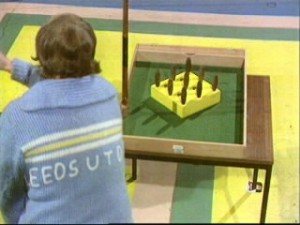 Ha, who needs Playstation 2?
Ha, who needs Playstation 2?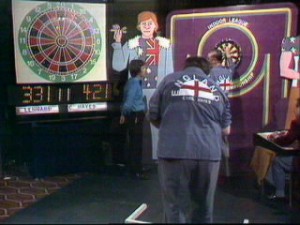 "101 in 6 darts or more..."
"101 in 6 darts or more..."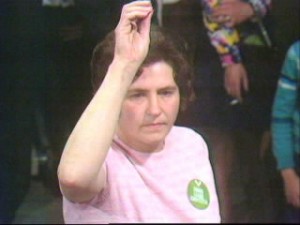 That's one way to hold it...
That's one way to hold it...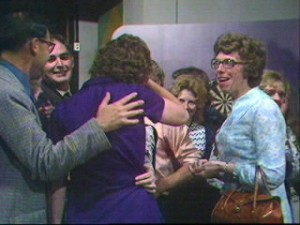 Women playing darts? Whatever next?
Women playing darts? Whatever next?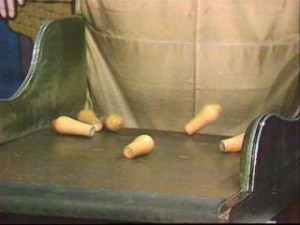 Nope, not a clue what this is.***
Nope, not a clue what this is.***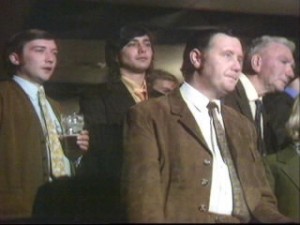 A frenzied crowd looks on.
A frenzied crowd looks on.***Footnote: Ian Dolby adds: "I thought you might like to know that Picture 5 is actually a Northamptonshire Skittle alley with some of the skittles knocked over. The idea of the game is to throw a two inch thick, 5 inch diameter disk called a cheese at the skittles in order to knock them over. This is a very dangerous game when played by novices as they are usually crap and this results it the cheese hitting the padded sides or front of the table and flying off in random directions around the pub. I have lost many a good pint in this way."
And John Mills says: "This is Northamptonshire Cheese Skittles (though the table looks like a Leicestershire one - sacrilege), amazingly still surviving and enjoyed in many pubs and clubs around Northants an over the borders into other counties. One participant in TIL competition still plays in my local league (Islip and District, East Northants). No other competitive phyical game to my knowldge has male and female players with an age range from teens to 90's playing."
Simon Puckrin adds: "I can also confirm Ian Dolby and John Mills' correct naming of Cheese Skittles in picture 5 and although the competition was dominated by the Northamptonshire Boys (3 semi finalists and both finalists) the only competitor whose name I can recall was Leicestershire's Hayden "Budgie" Crane, a player it was claimed on the show had lost many stones in weight recently, now down to a fighting weight of 21 stones. Budgie was eliminated in the semi finals." Simon also tells us: "The female darter with the caption "That's one way to hold it" is Mrs Jessie Catterick from Easterside in Middlesbrough who was beaten in the final of the 73/74 season (the first year networked) by the lady in the purple dress in picture 4, Mrs Loveday King (yes, Loveday is her christian name!) who I believe was from the Devon area."
See also
Weaver's Week looked at the first two series in 2012, after they were repeated on cable telly.

